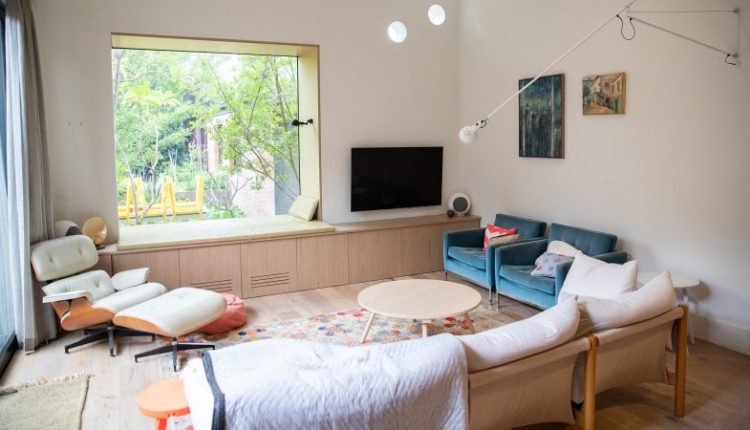After years of saving, Jordyn Carias and her partner purchased a home for the first time last month. To find a place that didn’t break the bank, she said, they had to go smaller.
“We had a lot of things we wanted in our first home, but after looking at the price range, we had to reassess,” Carias, a graphic designer who lives in Muscatine, Iowa, said.
Compared to other countries, America is known for bigger cars, portions and take-out coffee cup sizes. For most of recent history, Americans have also wanted bigger homes — but now that’s changing.
For most of the last half-century, new single-family homes kept growing. In 1973, the median size of completed single-family homes was 1,525 square feet, according to US Census data. By 2015, that number had ballooned to 2,467 square feet.
But as the cost of buying a home has exploded and McMansions have fallen out of favor, homebuilders have reversed course, building smaller homes with an eye to first-time buyers. In 2023, the median single-family home built was 2,233 square feet, down 9% from the 2015 peak, with many formal dining rooms and “bonus” rooms disappearing.
Carias and her partner ultimately settled on a roughly 920-square-foot home. To maximize space, they decided to use the basement as their primary bedroom.
“The broader trend in larger homes had been driven by what consumers wanted and demanded,” said Alan Ratner, a homebuilder analyst at Zelman & Associates. “More recently, we’ve started to see that flip almost out of necessity, because of how challenging affordability is right now.”
Homebuyers are warming up to the idea of smaller dwellings: According to an April study from the National Association of Homebuilders, the typical buyer wants a home that is 2,067 square feet — still smaller than the typical new home size last year.
Carias’ new home was built nearly 100 years ago. Today, smaller, often more affordable homes under 1,000 square feet are harder to come by in most US suburbs.
That wasn’t always the case. For a period beginning in the late-1940s, “Levittown” homes came to define suburban living in post-war America, Jacob Anbinder, a historian at Cornell University, said.
The housing developments, which began in the New York suburbs but spread elsewhere in the US and Puerto Rico, often fit eight 750- to 800-square foot homes on one acre.
“As many Americans became wealthier over the ’40s, ‘50s and ‘60s, they wanted higher living standards and the larger homes that came with them,” Anbinder said. “There was almost continuous upward growth in the size of new homes.”
Today, most of the original Levittown homes no longer exist, according to Anbinder. Over the years, homeowners expanded or demolished them in favor of larger spaces.
That upward growth trend has largely tapered in recent years, though.
According to an NAHB survey, 17% of homebuilders said they built homes on smaller lots in 2023 to support home sales, and 14% said they built more townhouses.
Earlier this year, D.R. Horton, America’s largest homebuilder, said it planned to reduce the size of its homes “to address affordability for homebuyers.” In a July earnings call, the company’s chief operating officer, Michael Murray, said D.R. Horton’s average house size was down 2% compared to last year.
There are signs those efforts might be helping buyers get in the door: The median sales price of existing homes jumped to $426,900 in June, according to the National Association of Realtors, while the median price of new homes in June was $417,300, according to the US Census Bureau.
Smaller homes and fewer amenities
Heather Eisenmann, a Realtor who specializes in selling new construction in Clarksville, Tennessee, said that she’s noticed that many of the new homes she shows now have smaller bedrooms and living rooms. Many no longer have freestanding tubs to save on bathroom space, and formal dining rooms are often swapped out for kitchen islands built for bar seating, she said.
“Three years ago, we were building in a subdivision called Easthaven. Those homes were 2,500 to 3,200 square feet,” she said. “Everything I put on today is under 2,000.”
Eisenmann said she’s also recently noticed that some homebuilders are skipping expensive appliances and “extras” like fences and window treatments to lower a home’s list price, a strategy she thinks could backfire and repel first-time buyers.
“New construction is appealing to a first-time homebuyer because it requires little to no maintenance,” she said. “But when they start looking at new homes that don’t come with all the appliances, most of my first-time homebuyers want to turn to existing homes.”
Carias, from Muscatine, said she’s happy with her new under-1,000-square-foot home and doesn’t have plans to move anytime soon. She and her boyfriend relocated from the Sacramento area back to her hometown to find a home within their price range.
“Our biggest goal was getting to carve out a tiny little slice of something that is ours and not throw away our money on renting anymore,” she said. “I am so excited to paint and do whatever I want.”
Read the full article here

